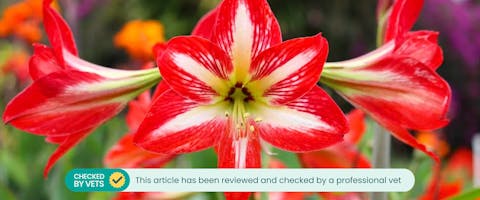Updated 29/09/2023
Native to South Africa but loved (and displayed) worldwide, amaryllis (otherwise often referred to as amaryllis, Amaryllidaceae, Jersey lily or naked lady lily) are funnel-shaped flowers found in a variety of vibrant shades. But with many of us experimenting with different flowers in our backyards, it begs the question - is amaryllis belladonna safe for dogs? Well, here we explore just that, so sit tight to get in the know below.
Trending posts
Purr-use some of the top blogs our members have been loving this month- Top male dog names for your new furry friendGot a new furry family member in your pack? Check…

- Top female dog names for your new fluffy palWelcoming a new pooch into your family? Explore…

- 250+ gray cat names your silver feline will loveRecently welcomed a fluffy gray bundle of joy into…

- What are normal pet sitting rates?Discover the average pet sitting rates for animals…

- Unique dog names to stand out from the packDare to be different with our list of the best…

Is amaryllis belladonna safe for dogs?
No, amaryllis belladonna is toxic to dogs, so you should try to keep your pup as far away from the plants as possible. The plant contains a compound called lycorine, which is particularly concentrated in the plant’s bulb. If your pooch (or a human!) nibbles on any part of the plant, they could fall victim to the nasty symptoms of amaryllis toxicity, which includes lethargy, tremors and gastrointestinal issues. So, if your pup is particularly prone to rummaging, digging and nibbling in your garden, it’s not a great idea to house amaryllis belladonna with your pup’s safety as your top priority.
Amaryllis poisoning in dogs
So, now we’ve established that amaryllis belladonna and dogs simply don’t mix, let’s dive into the symptoms dogs who’ve consumed the plant might experience. We’ll also take a look at some of the methods of diagnosis your vet may take and the possible treatments that might be administered. Before we get into any of that though, it’s worth noting that if your pup has eaten any part of an amaryllis belladonna plant, you should contact your vet as a matter of emergency to get advice and a check-up.
Symptoms
- Nausea
- Drooling
- Vomiting
- Diarrhea
- Tremors
- Low blood pressure
- Respiratory distress
Diagnosis
If you suspect your pooch has ingested part of the plant, take a sample of it with you to your vet appointment if you can – this will help to speed up diagnosis and therefore treatment. Also, try to have an idea on the amount of the plant your pup ingested, how long ago they nibbled on the plant and when the symptoms of toxicity started or when you noticed a change in behavior. During your appointment, your vet will physically examine your pup to check their weight, heart rate, pulse and blood pressure, plus they may administer blood tests to check the severity of dehydration.
Treatment
If your pup hasn’t vomited yet, your vet may choose to induce this so that as much of the toxic compound can be removed as possible. Inducing vomiting is effective within the first 4 hours after ingestion and can limit the amount of toxin exposure. They may also administer activated charcoal to soak up the toxic compound. Unfortunately, any vomiting can cause dehydration, so your pup may also need intravenous fluids and other supportive therapy to combat this. There is no antidote so treatment is largely supportive and symptomatic.
Meet our veterinary expert, Greg
This article has been checked by veterinarian Dr Greg Steele MA VETMB MRCVS. A mixed vet working in the UK since qualifying from Cambridge University in 2015. Greg enjoys working with all species of animals in all settings, but equally takes pride in communication and education of clients too. He lives with his wife and their cat, and enjoys a variety of sports, gardening, and the great outdoors.

